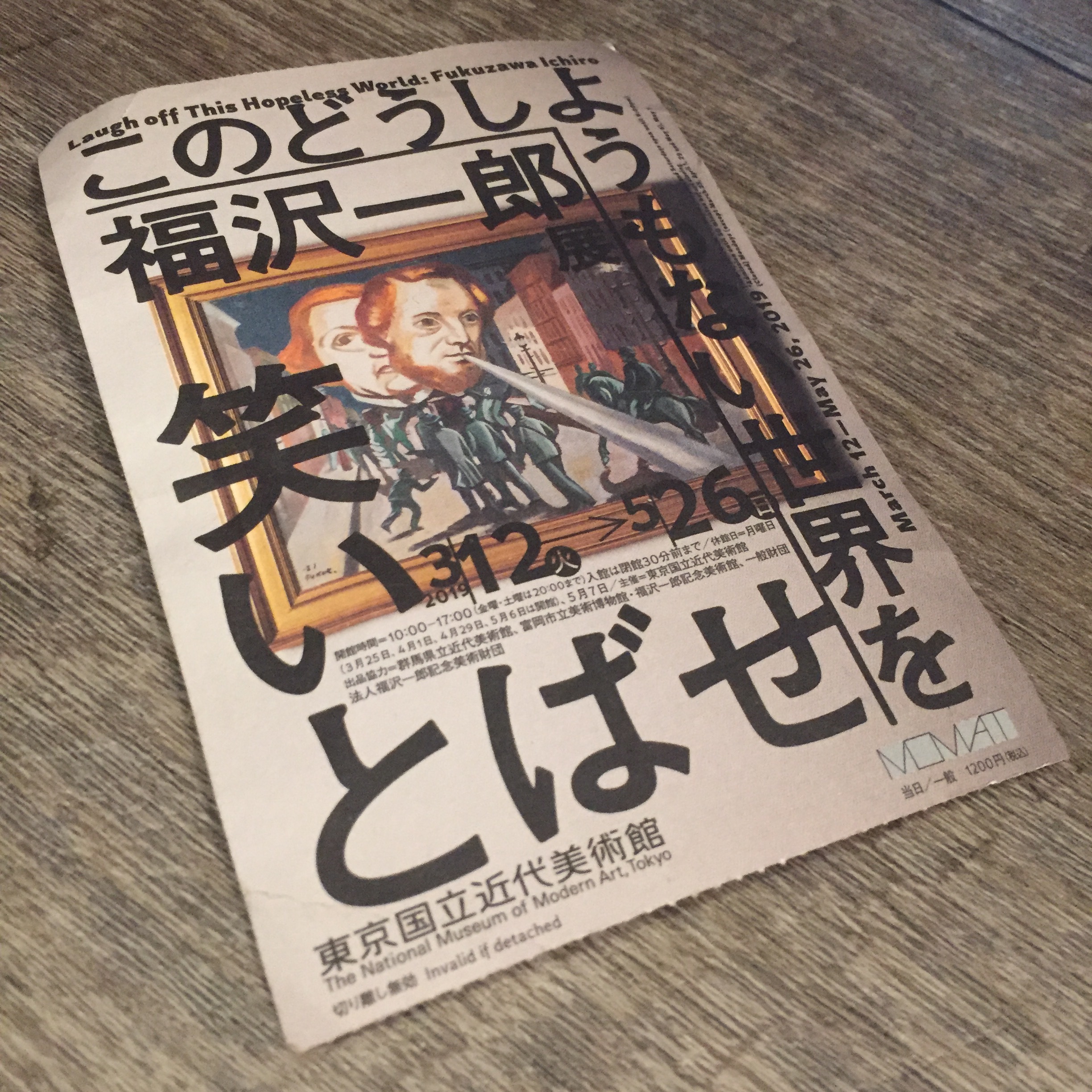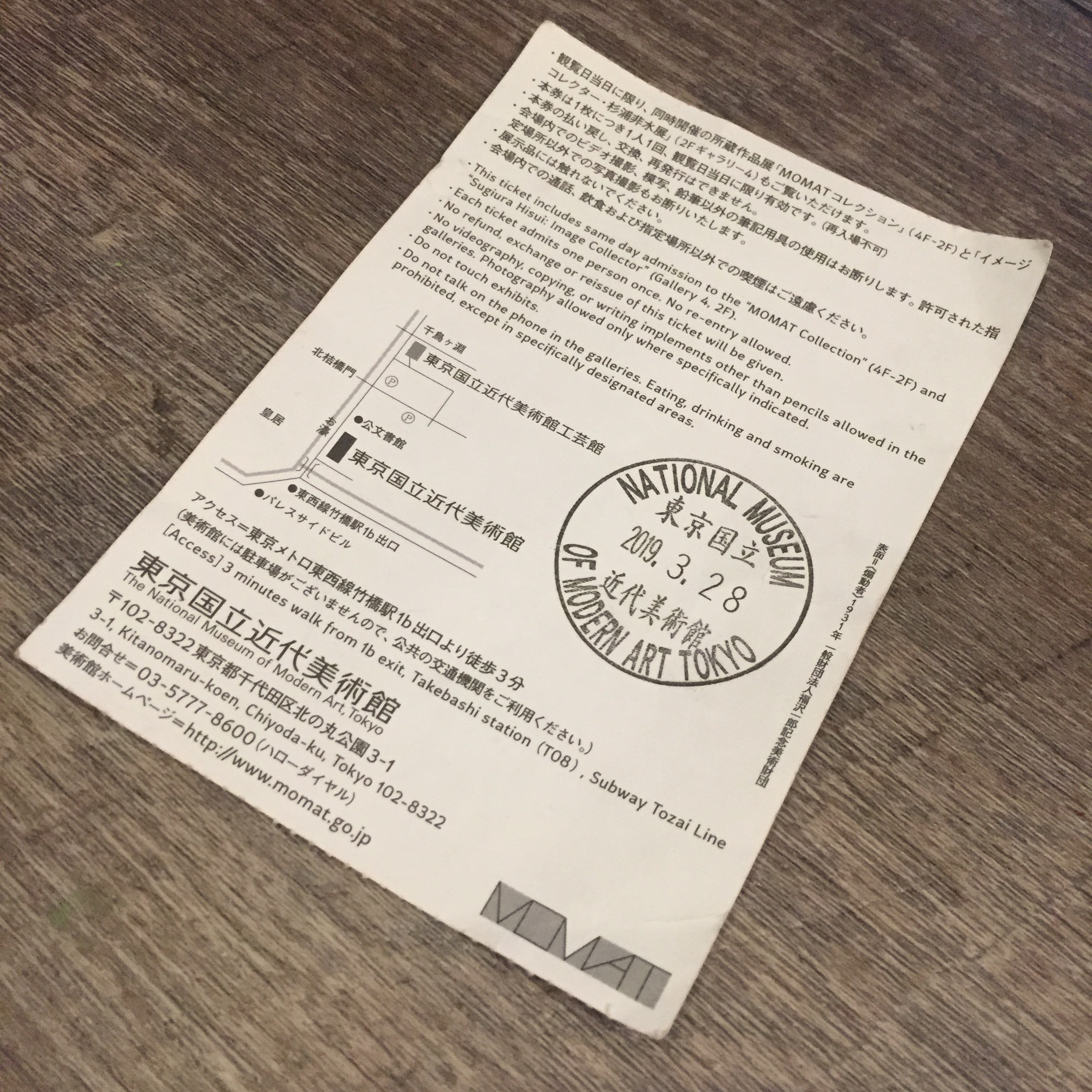This weekend, I sat at my computer on Easter Sunday and thought, “This seems like as good a day as any to finally tackle a blog about that stunning Japanese surrealist show in Tokyo!”
So here we go.
Instead of allowing visitors to take photographs, museums and galleries in Tokyo like to give out these comprehensive lists of pieces in the show:
But even after diligently packing this exhibition list and bringing it back home with me to Maryland, I couldn’t find Fukuzawa Ichiro anywhere on the internet. The World Wide Web hasn’t served me an empty plate since 1998, so this was a pretty strange feeling. Turning over rock after rock on Google produced no Fukuzawa spiders, and even Pinterest and Wikipedia had nothing to say:
Was I going insane? Had I actually gone to Japan and seen the show? Did the artist really exist?
At least I still had the Exhibition Lists as proof, but for a while, I had one of those Sixth Sense moments where I worried that I Was The Ghost All Along.
After typing and retyping into Google, I found a low-res image of this painting “Lie Detector” which struck me to the bone at the show. I was so sad that all I could find was this small, diffused reproduction.
The painting shows a machine pulling a purple matrixed form out of a shadow. While seeing this painting in person in Tokyo, I stared at it for something like five minutes and tried to think about it in a way that made sense. Which other artists paint like this? Who does this remind me of?
It floored be because it wasn’t like anything I’d ever seen. The part of the brain that likes to serve up comparisons came up as empty as Wikipedia.
And that’s fine. My least favorite form of art criticism is when writers try to explain artists using mashups of other artists: “Like deChirico, yet also like a Pink Floyd album cover.” The reason why I hate this is because I do art. Most artists don’t like to be called “The Disney of Japan” — although, our most adept art writers can sling out flattering mashups that manage to not insult the artist or the audience (Like Steve Ditko meets Lady Gaga, okay, all right, if someone throws you a bone, I won’t take it away). Talking about artists in terms of other artists makes sense most of the time. All art does come from life, and artists usually do reference each other’s work and go to museums and get ideas, right? Artists are all butterflies of different spots and stripes, in the same case.
This artist can’t be pinned down in a tidy mashup oneliner. He’s like a large shining scarab amongst butterflies - and I fucking love it.
When you find an artist who is wholly themselves, it’s good to stay a while.
A couple steps down from Lie Detector was this stunning painting: “Science Blinding Beauty.” This painting struck me as both dramatic and funny - It’s like she angered a conscious sextant and it launched into her face in Payback Mode, and then a surveying tripod joined in for a full-on instrumental dogpile.
Yeah, most other artists love to depict “Beauty blinding science” or “Love is Blind” and almost 100 years ago (1930s) here comes Fukuzawa Ichiro with the flipped coin. Wouldn’t it be funny if it were all the other way around?
In the same hallway as “Science Blinding Beauty” and “Lie Detector” is the painting depicted on the cover art for the show:
This 1931 painting works as the Gateway Drug Painting for Fukuzawa Ichiro - it’s weird, it’s of it’s time, Ernstian, and it is titled like a Magic the Gathering card (Agitator). I don’t exactly know what the greenish people did to piss off the giant graybeam-spewing heads, or what the heads are or who they are supposed to be, but, okay, I can roll with it. Maybe the heads aren’t supposed to be anyone. You kind of get the idea that these Eternal Pissed Off Heads that could appear in any place or time, if you’re unlucky enough.
I could be wrong and the enlarged redheads could be benevolent, spewing gray lazerbeams of what, happiness? Light? But I doubt it, given the title.
Part of the challenge of finding Fukuzawa Ichiro paintings online seems to be that the titles could be translated multiple ways from Japanese to English, so, when I key in the titles from Ye Olde Exhibition List, I summon up a series of very uncertain Google results.
This painting below from the show is titled in English: “In a world disorderd as my disheveled night gown, I do not know whose wife I will be tomorrow”
It was in this room of the show where the paintings were just so freakin good that I transcended my social anxiety and asked the security guard if photos were okay (Shashin wa daijobudesuka?). Answer: Dame des, No. My veering heart hit an iceberg.
This painting, along with the similar painting next to it, had such lengthy titles that I almost felt like Fukuzawa Ichiro was purposefully making life difficult for future art historians - laughing at us. Even if the art historians had infinite books and computers beyond anyone’s wildest dreams, it would still be hard to pin down these paintings.
But once you FIND these paintings they make sense - the courtesan of war is sitting and reading a scroll, while a pile of dead men seems to be accumulating partially off-screen. Who knows whose wife she will be tomorrow?
Paintings like these are Ichiro at his best - in other moments he tries to be a kind of Dali, where lichenistic shapes of paint are cows, but they are also countries. This isn’t a good look for Fukuzawa Ichiro. It’s not his Sunday best - I get his energy and what he wanted to say, but his other paintings (above) are so much better.
Along the lines of “I do not know whose wife I will be tomorrow” - The shortness of life seemed to be a theme for Fukuzawa, but he lived into the 1980s. He made so many paintings about hell, Dante and Virgil touring hellscapes together. Artists do not fear hell in Japan, in fact, every show I went to had it’s own version of Hell. Sometimes Hell looked pretty rad, and you find yourself asking how there aren’t more Hell Courtesan Animes:
This show of Fukuzawa Ichiro’s work in addition to a simultaneous show of Asana Tadanobu at the Watari Art Museum proves that Japan does “funny” way better than the States and most of Western Art. They are okay with fine art being funny. They are okay with fine art being funny. They are okay with fine art being funny.
The whole world is lucky to have Jim Carrey working on art now. But we only just got here with Jim Carrey! There’s so much more to do.
After the show tours you through every Fukuzawa Ichiro painting that could be mustered, at the very end of the show you see this painting, it’s something like 15 feet tall:
Title: Toilet Paper Hell
Looking at this painting, I definitely had flashbacks to watching people riot over toilet paper at Costco before Hurricane Harvey. It looks like an awful time, this Toilet Paper Hell, but it’s also pretty funny. Why are these people seemingly tortured or killing themselves over … toilet paper? I don’t think I will ever know.
Sometimes asking Why with art is as pointless as worrying about Hell, and we should all just relax and laugh. Lol.
When I visit museums I always skip the audio tour and never read the placards. No reservations, no context, no worries, no regrets, my friend!
My habit of not participating in reading the Manual of Art emerges from my own belief that art can stand alone - any art that needs an explainer or a statement is probably not worth looking at.
More than this, artists want you to look and see with your own eyes. The smiling Jedi-knight ghosts of Artists Long Dead don’t want you to have the spoilers of history or context. If it’s funny, it’s funny. If it’s beautiful, it’s beautiful. If it’s sad, it’s sad.
Fukuzawa Ichiro’s paintings are well-titled and well painted, and I am happy to say you don’t need to read the placards or explainers or find him on Wikipedia in order to get him, to laugh with him.
While in Japan I was lucky to see this show https://www.momat.go.jp/english/am/exhibition/fukuzawa/, it’s still online for one more month! Go see it!













